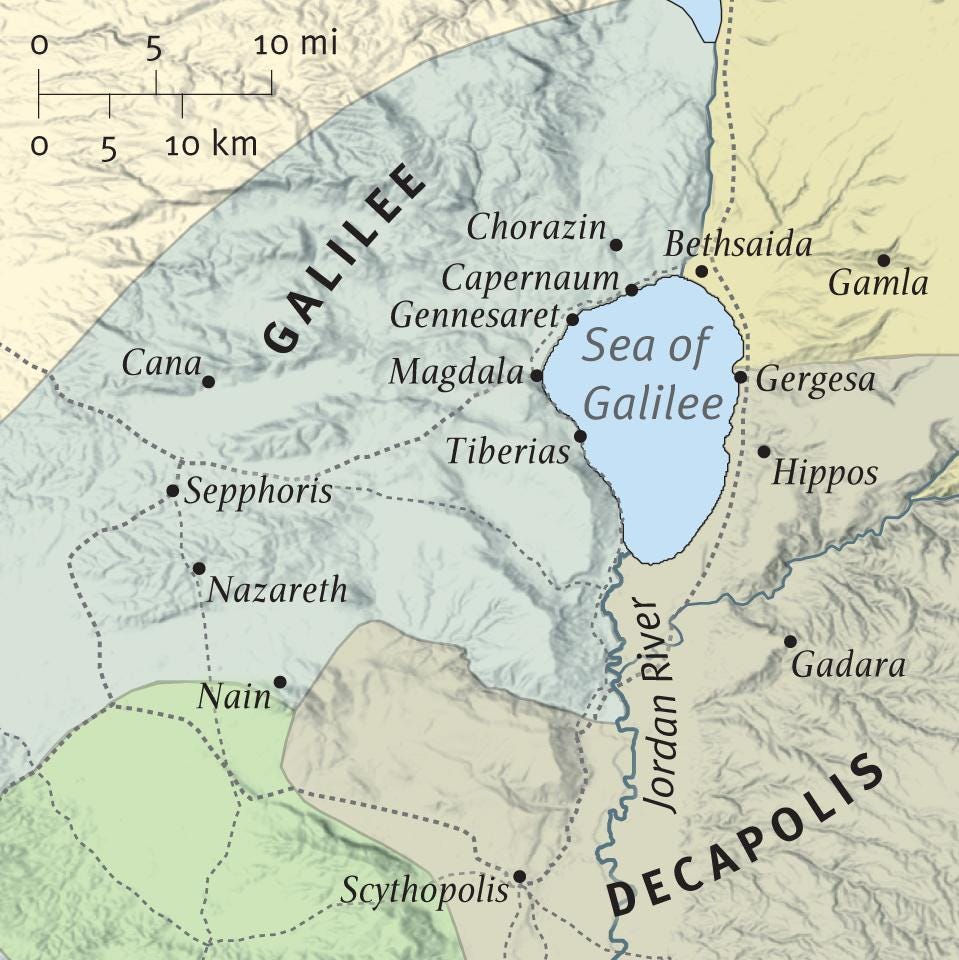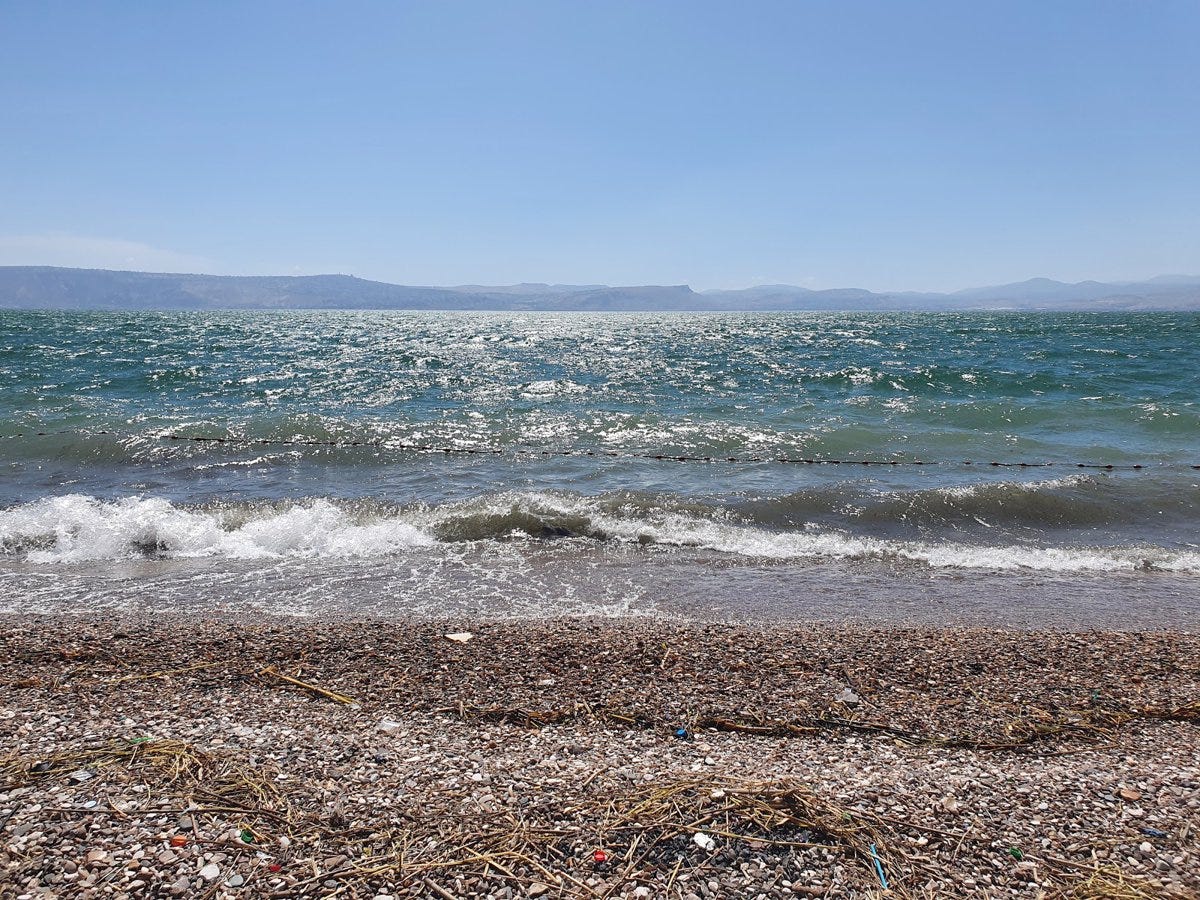The next pericope in our synopsis looks to have originated in the Gospel of Mark and Mark’s version looks to have served as the source for Matthew’s version. By the time this tradition reached the Syriac Christians who produced the Gospel of John in the early second century, much of the detail had shrunk to a rather generic mention of the episode. The Markan version probably got its details from the earliest tradition of the story we could conjecture; Matthew probably added a separate story about Simon Peter calling out to Jesus; and John probably only heard the general contours of the tale.
Geography matters a little for how the events of the story unfolded. Mark has Jesus and his disciples near Magdala or Tiberias, and then putting out to water in boats and heading toward Bethsaida across Lake Gennesaret. This would mean starting on the west point of the lake and moving diagonally northeastward. Immediately after this crossing, however, Mark has Jesus and the disciples in “the land of Gennesaret,” meaning the village (not the lake) also called Gennesaret. John’s account sets up an opposite motion, going from Bethsaida and stopping in Capernaum. A quick glance at our trusty map shows how such pathways don’t agree with each other:

Just where did the disciples get stuck on the open water? Mark says Jesus directed the disciples to sail toward Bethsaida across the lake and then he went separately up a “mountain” (hill) to pray alone. Then the wind kicked up, and the disciples found themselves rowing against choppy water. Seeing this, Jesus descended the hillside and walked toward them on the water. Here’s why the geography (sort of) matters: had they left Bethsaida for Capernaum, they wouldn’t have crossed over much open water but rather have adhered more or less to the shoreline. The story doesn’t make sense unless they’re out in the middle of the lake pushing against contrary wind. What seems geographically probably is that the group had departed either Tiberias or Magdala (or a point in between) for Bethsaida; because of weather, they stalled and ended up in Gennesaret (Mark and Matthew) or Capernaum (John), short of reaching their intended destination. Jesus walking on the water toward them in the middle of their voyage would presuppose a shortcut from somewhere on the northeastern shore toward the nothern-middle section of the lake.
From Kursi Beach (where Gergesa appears on the above map), one can see the opposite hillside and the lake in between. The disciples could easily have seen Jesus approaching over open water; the question has more to do with what kind of moonlight or other light source made him visible and at what distance. John has the group rowing between 25 and 30 furlongs before seeing Jesus; the original text gives Roman stadia as the measurement, putting this distance at around 2.75 to 3 miles. If we draw a straight line between Tiberias and Bethsaida, and then slice it at 2.75–3 miles, that puts them roughly parallel to (and about 2 miles ashore of) Gennesaret village.

Fourth Watch of the Night
Mark and Matthew say that during the “fourth watch of the night” Jesus went out to the disciples, who were stalled by rough winds over the water. We don’t know what time that would have meant because (1) the Jewish system didn’t have a fourth watch and (2) the Roman system shifted with the season. Put simply, the Romans treated nighttime as sundown to sunrise, and their system divided the night by twelve, then rotated watches based on those intervals. So, hours varied with the seasons, making the time intervals by our reckoning longer and shorter over the year. The Roman fourth watch occurred between 3:15–6:10 AM in the spring; between 2:10–4:30 AM in the summer; between 3:00–6:00 AM in the fall; and between 4:00–7:45 AM in the winter. Taking the broadest ends, this reference to the “fourth watch” could have meant anytime between 2:10–7:45 AM. What’s more important in this reference to the “fourth watch,” in my mind, is that the gospel writers clearly intended for all this event to have occurred at night and not at twilight or just before dawn.
Haunting Specters
When the disciples first detected Jesus walking on the water, they took him for a “spirit” and cried out “in fear” (according to Matthew). But Jesus replied, “Be of good cheer; it is I; be not afraid.” Roman and Judaean sources are replete with stories about “specters” and ghosts, particularly of Roman emperors who were said to have haunted others. Many stories described an ethereal sphere underneath the sandals of the specter, a reference to the globe of earth and the deceased emperors’ demigod status over it. Other stories, especially those of the common folk variety, treated water as a hazard to ghosts, a barrier that protected the living from a haunting specter.1 The Markan community may have intended their version to elevate Jesus: he had power over the waters while malevolent spirits did not. They may just as easily have intended to portray Jesus like the departed emperors of Rome, a kind of demigod with the watery earth under his sandal. In any event, the disciples appear like common fishermen, who, as a class of ancient society, had many tales of water specters, apparitions on the shore or in the sky that haunted their voyages.
The Markan account does not end on a positive note. The disciples, it says, were “sore amazed” (existēmi = amazed/insane/mad/out of one’s mind) “in themselves beyond measure” (perissos = (literally) exceeding exceedingly), “for their heart was hardened.”
Simon’s Part
The Matthean account adds an element involving Simon. It says Simon answered Jesus by calling out, “if it be thou, bid me come unto thee on the water.” Jesus replied, “Come,” to which Simon “[came] down out of the ship” (katabainō = step down/dismount/descend) and “walked (peripateō = step) on the water to go to Jesus.” But seeing the blowing wind, Simon was afraid, and began to sink. He cried out, “Lord, save me!” And immediately (eutheōs = immediately/right away) Jesus stretched out his hand “and caught him.”
Much has been made of this moment, many lessons drawn from Simon’s steps on the water, his fear, his starting to sink, his crying out, and Jesus catching him. I think we have some indications from the text that Simon didn’t actually stand on the water, but sank immediately. The Greek phrasing suggests this more than Simon making any step at all. It’s at this moment of Simon stepping off the boat that he sinks. We have to imagine, also, that this is a windy situation, water getting chopped enough to stall boats with a dozen (at least) men rowing. And we know from recent tragedy how choppy conditions on a relative shallow Utah Lake have been enought for perfectly capable swimmers to drown. Regardless of Simon’s ability to swim, he sank immediately, struggling right away. This whole sequence of events could have lasted only a few seconds, at least the way the account runs. And Jesus was close enough to catch Simon. The way I imagine the scene, it all occurs rather simultaneously: Simon steps away from the boat’s edge and plunges into the water, and he calls out to Jesus, who lunges down to catch him and hold him up. And as they climb back into the boat, the wind ceases.
Fear and Jesus
We return to that important word pistis, what appears in Jesus’s words to Simon: “O thou of little [pistis], wherefore didst thou doubt?” I would translate this differently by trying to evoke the sense of trust embedded in the word pistis. Oiligopiste eis ti edistasas? (Small-truster, why did you waver?) The whole phrase, which is quite punchy and tight in those four Greek words, resembles how parents in other literature speak to their children when trying to reassure them. “Why did you worry so much?” or “Why did you lose confidence?” are close to what Matthew quotes Jesus as saying.
We usually read this as Simon not possessing enough faith to walk on water, as though Simon’s sudden realization that people don’t walk on water caused him to falter, or he just didn’t will himself enough to pull off the miracle. However, I think the text establishes that Simon simply feared the wind. At no point does Simon appear to have lost confidence in Jesus—he didn’t hesitate to call out to Jesus for help. Jesus’s words to Simon could simply have been to reassure him about starting well and not fearing. We could draw a parallel here with D&C 9, an 1829 revelation directed to Oliver Cowdery after Cowdery had failed to translate a portion of the Book of Mormon and wondered what had gone wrong. The Lord’s reply to Cowdery said that Cowdery had started well enough, but he had “feared,” and the time to translate had passed. The Lord promised Cowdery that nothing really had changed—he was still blessed and would continue in the Lord’s grace—only the time for him to translate was no longer “expedient.” Simon and Cowdery both had initiated their actions, asking the Lord to perform something miraculous, and both had feared, and the time for both of them to accomplish the thing they had started had then closed as a consequence.
Jesus’s part in the story began with him calling out to the disciples to “be not afraid.” It ended with Jesus asking Simon why Simon had feared. This is a story that puts fear opposite of Jesus. Jesus reassures us, even in our failures, not to give into fear, not to lose trust in him. Keep our chins up, trust on, hold on. Don’t fear the wind with Jesus nearby. Don’t fear the choppy water. Don’t fear the dark night. Don’t fear at all. Jesus is always, always nearby.
Matthew James Ketchum, “Specters of Jesus: Ghosts, Gospels, and Resurrection in Early Christianity” (Ph.D. diss., Drew University, 2015), 57–109; Jason Robert Combs, “A Ghost on the Water? Understanding an Absurdity in Mark 6:49–50,” Journal of Biblical Literature 127, no. 2 (2008): 345–358. ↩